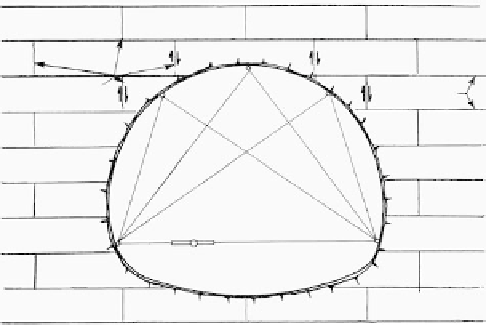Environmental Engineering Reference
In-Depth Information
IV
Bedding
planes
Joints
III
V
FIGURE 4.9
Convergence meter pin array for
horizontally bedded rock in a tunnel. (From
Silvera, J.F.A.,
Proceedings of the 1st Congress
,
Brasileira de Geologia de Engenharia, Rio
de Janeiro, August, Vol. 1, 1976, pp.
131-154. With permission.)
II
I
Convergence meter
VI
V
IV
III
FIGURE 4.10
Convergence meter pin array for dipping
rock structure in a tunnel. (From Silvera,
J.F.A.,
Proceedings of the 1st Congress
,
Brasileira de Geologia de Engenharia, Rio
de Janeiro, August, Vol. 1, 1976, pp.
131-154. With permission.)
I
II
Convergence meter
Fault zone
deflection are not known. If creep occurs in the wire, accuracy reduces to values of about 0.2
to 0.8 in. (Silveira, 1976).
The Bassett convergence system
is a more sophisticated system. Tilt sensors are used to
monitor the position of reference pins installed around a tunnel section (
Figure 4.11b).
The
sensors are linked to pins by a system of arms. Spatial displacement of the pins results in
changed tilt readings that are recorded on a data logger. A computer calculates displace-
ment data and generates a graphic display of tunnel displacements. Deformations as small
as 0.02 mm can be detected.
4.2.5 Vibration Monitoring
Purpose
Ground motion is monitored to obtain data for the evaluation of vibration problems asso-
ciated with blasting, road and rail traffic, pile driving, the operation of heavy equipment,
and rotating or reciprocating machinery. Ground motion monitoring for earthquakes is
discussed in
Section 11.2.3.
Equipment
Small portable seismographs (particle-velocity seismographs) are used to determine fre-
quency, acceleration, and displacement of surface particles in three rotational directions of
vibration motion (see Section 11.2.3). They also record sound pressure levels.






